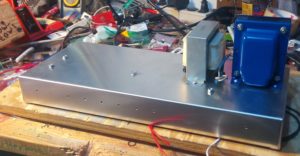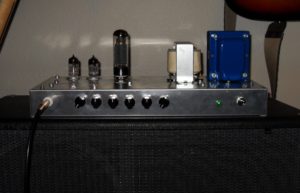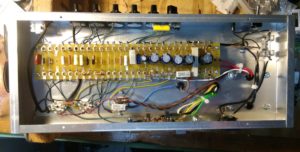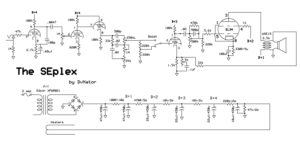I have never been much of a fan of single ended amps. I started modding amps with a Valve Junior and no matter what I did to it it always sounded pretty bad. My first build was the Two Stroke single ended amp from Dave Hunter’s book and that was way better than the Valve Junior but it eventually evolved into the Sangria.
I had never done a big bottle single ended amp because that seemed to make no sense. The iron would cost a lot and it wouldn’t even sound as good as a push pull 6v6 amp. However, after building a ton of smallish push pull amps and despite all my misgivings I decided to try a big bottle single ended amp anyway.
I decided that one of the problems with many single ended amps was just the concept of taking a random preamp and putting it in front of a power tube without regard for the phase inverter and, usually, negative feedback (more on that later). For the basic circuit I went with a single ended plexi design. A Marshall Plexi based single ended amp has obviously been done before but I wanted to do something about what is normally missing as far as phase inverter gain and negative feed back.
I had built other Marshall Plexi based amps like the 6F4Plexi and decided, based on that experience, that the normal channel was not essential. So instead of using a triode for the normal channel I decided to use that triode for a gain stage after the tone stack where the phase inverter would normally be. I also though this stage could be used to return NFB to. So that’s basically what I had in mind building this.
Here are some progress pics:
I’m using a bud box for the chassis and it worked out pretty well.
Overall the build came together pretty well. I’m using a Weber WSE15 for the OT and the PT is a Edcor XPWR021 which has a 290v output and gets me around 355vdc rectified at the first node. The tag board I’m using allowed the use of radial filter caps which I’ve found are a much better deal than axial caps. I’m using some 22uF
and some 47uF.
I had done an early schematic and pretty much stuck with it after firing it up and trying it out some. Probably the biggest change I made was decreasing the the first coupling cap from .02 to .0047. The fact that it was better with NFB (like a real Marshall) indicated to me that I was on the right track design-wise. BTW, The negative feedback circuit came from the 5E6 Bassman but I’m using a slightly bigger feedback resistor.
Here is a layout I have been working on. It’s basically the layout that I used and it’s based on using a universal board like this. There is no switching in this layout.
So despite all the questions I had about building a single ended amp I’m really happy with the way this one came out. Getting good EL34 tones at a reasonable volume is tough and this one sounds pretty good. I think having the triode after the tone stack does allow the power tube to be driven better than many designs that have the tone stack and a master volume directly in front of the power tube. It’s probably about 10 watts and it can get loud. I haven’t played it with a band but I would guess that it could keep up with a sane drummer.
Here is a clip:
Since doing this clip I have added a small 100pF cap on the first triode going from the plate to the cathode. This trims the very high frequencies a bit. It’s on a bunch of different Marshall amps.





Like the SE Plexi. Very cool. Wonder if I could pull something similar off using 6SL7’s in the preamp. Gain would be lower but it might be cool. Not as well versed as you with this stuff though. But it would be a learning experience either way. Love your site.
I would think 6SL7s would work fine though I haven’t used them myself. It would be a little lower gain.
I am interested can it be used in an parallel single ended design… But this parts with fake phase inverter has to be explained a little bit more
The fake PI is just another gain stage to replicate the gain of a PI. Nothing that special about it.
Hi, thanks for providing this project! I am considering building something similar, but would love to have a reverb circuit (like Fender Princeton 1164) added in somewhere. This is a gain-sucking mod but I may try to incorporate it into yours, and do away with the boost switch. If it was a little gainy before perhaps it would be a good fit with the original version of your amp. I would also like to possibly try one with an EL84. Thanks again for this post!
I’ve been thinking of design like this, but using a KT88 and hopefully putting out 20w or so.
Only thing is I’m considering the use of 3 12AX7s to get the normal channel and a cascade switch. I also came up with something more like half a phase a inverter and less like a simple stage, just so the NFB can work as it was intended to.
Will probably end up using a 50w JMP/JCM PT clone to power everything the right way and don’t come short on that KT punch.
Any advices?
I don’t really have any advice. It sounds like you have a good plan.
Good luck with the build.
salut
j’ai un PT ( TT 56VA ) toroidal de chez tube town . pense tu qu’il serait ok pour cet ampli ? … merci
Est-ce celui-ci?
https://www.tube-town.net/ttstore/Transformer/Power-Transformer/Toroidal/Toroidal-56VA::4908.html?MODsid=1q2gpkts2eb7k6q0sr516sfp81
Cela pourrait être le couper avec un EL34. Je pense que cela fonctionnerait avec un 6V6.
Hey there dvnator,
I like what you have done. I *really* like your sound clips. I’m modding my AX84 SEL to me more Plexiful, and it’s going pretty well. I have dropped the power rail to Plexi spec, worked on the tone stack, etc. Seems like a little much to juggle all the stages around to make it like the SEPlex, but I am giving the negative feedback a try. I ran a wire from the 8 ohm tap going right into a 33k resistor, then into the cathode at stage 3. Seems to be working pretty well. At first I was puzzling over the idea that NFB is usually delivered to the last stage before the power tube, but I could not figure out how to add it to a cathode follower. Looked like a bad idea. What do you think of how I did it? I ask because I have not seen a huge change from the NFB. http://www.ax84.com/static/sel/AX84_SEL_101004.pdf
Re-did the NFB. This time I sent the feedback to the output tube (KT88). I just ran straight to the cathode, but with a 68K resistor this time. As soon as I turned the amp on I knew it was right. Much better now. Sounds great.
Hello dvnator, awesome work (and sound)!!
I’m about to start a build of a plexi SE, and being a newbie (I’ve built a couple of amps up to now, but only followed instructions, I wouldn’t be able to design one). I was almost buying the plexi SE PBC (due to my newbiness) but will go instead for your design. I noted the layout here on the page still refers to V1, do you happen to have an updated version? If not, can you point me the changes I should make?
Thank you so much for sharing the knowledge, I owe you a beer already 🙂
Hi Fabio,
I don’t have an updated layout but here’s what you need to do.
In the layout there is a 470k resistor between a 1.5k and a 220k. It goes from the treble pot to ground.
You replace that resistor with two 220k resistors in series. Still going from the treble pot to ground.
The first lug of the boost switch connects to where the treble control connects to the 220k resistor you just put in.
The middle of the switch goes to pin 2 of V2b.
The third lug of the switch goes to the junction of the two 220k resistors.
That should do it! Good luck with the build.
Thank you so much for the response Dvnator! Only now I’m starting the build, I’ll post the results here (goal is to finish this year 🙂 )
The 33k slope resistor with the 500pf bright cap is why you have so much gain. Those are the 2204 jcm 800 values. A 56k/250pf would be plexi tone. The slope resistor also determines the mid roll off. So the 33k is more in your face with more gain. The 56k is more mid scooped and the 250pf def less bright. I like a 47k as a middle of the road. A 56k with a 390pf isnt bad either. Slightly brighter plexi tone. So you really have a SE JCM800.
How much of the tone is dependent on power tube saturation? I’m wondering how close just the preamp would be to capturing the mojo of a cranked plexi. It looks like the fake PI is simply driving the power tube hard rather than actually emulating PI distortion, which if I understand correctly, is very asymmetrical. It sounds spectacular, but I’m wondering how well it gets “that sound” at bedroom volumes.
The triode between the tone stack and power tube was more to emulate the gain structure of a Plexi as well as have a decent way of incorporating negative feedback and a presence control. Both of those things are important,IMHO, to “that sound”. Trying to specifically emulate PI distortion wasn’t a priority.
I think, in general, it’s pretty close to a Plexi sound but it’s still a SE amp and they will never sound exactly like a push pull.
Also, I don’t know if I’d consider it “bedroom volume”, it’s pretty loud.
I’ll build it but with a 6dq6b in the power output